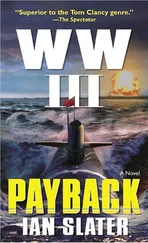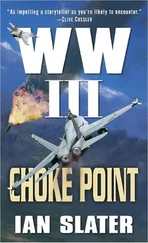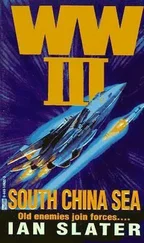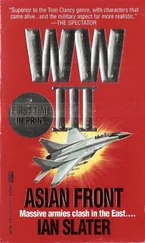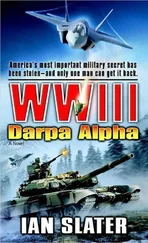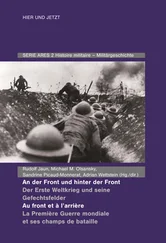* * *
“Outboard personnel stand up!” It was the sergeant aboard the C-130 transport high above the chaff, finishing his air safety check. “Hookup! Check static line!”
“Aw, shit!” responded the air force corporal, not seeing any humor in the sergeant sticking to normal jump procedure and wanting to get the hell out of Rat air space before “white tails”— Siberian surface-to-air missiles — began streaming up through the darkness. “Push ‘em out, Sarge. Let’s get the fuck outta here!”
Outside in the black void the stars were so bright the corporal felt he could reach out and grab them, but below the thundering roar of the airplane the blackness was absolute; the dark camouflage mushrooms of the T-10 static line were quickly disappearing into the swirling clouds of Arctic air — so cold that even with full thermal issue the corporal’s throat felt a hot burn of the freezing Arctic air. The fifteen-foot yellow static lines fluttered now like ribbons above the swirling, chaff-riven night.
In Ratmanov’s complexes one and two, north and south, the guttural Klaxons sounded, like submarines diving, as smudge-faced SPETS zipped up white overlays, snatched weapons from the rack, and raced for the spiral exit shafts that wound one hundred feet through the rock up to the wind-swept surface of the barren, snow-roofed island, ready to engage the enemy before they even touched ground. Five minutes later two Stealth F-117As swept in low at 690 miles an hour on a south/north run. Even at this subsonic speed they were over the five-mile-long island in twenty-seven seconds. Most of the chaff had now dissipated, and Siberian radar picked up one of the Stealths via ultrA-10w frequency radar and fired an SA-10 but missed.
Even though the SPETS were already out and had closed the triple-armor manhole covers of the exits, the infrared video taken by the Stealths in their twenty-seven-second overflight revealed the exits, the latter’s HE, or heat emission, spots distinct against the snow — showing up on the video film like white, overexposed blurs on a negative. The moment he was awakened and given the information — ten exits, five north, five south of the island’s midpoint — Freeman ordered them CMR’d — computer map referenced. It was done in less than five minutes. While his staff was exultant with the way he had dropped weighted chutes, duping the Ratmanov commander into sending out his troops and so revealing the exit/entrance positions, Freeman was too busy to celebrate.
“Alright, Jim,” he told his air commander. “Tell your boys we’re going to give ‘em the can of Raid — make up for what those cruise missiles of yours failed to do. Get them to drop three laser-guided babies on each of those exits. Two-thousand pounders. Mightn’t do the trick, but it’s better’n dropping dumb proximity iron bombs.”
The whooping continued in the revetted mobile home that was Freeman’s Prince of Wales HQ. “You suckered ‘em, General!”
Freeman told everyone to quiet down. It was true he had tricked the Siberians — a bunch of hotshot SPETS now running across the snow shooting at dummies or whatever the air force could put on the end of a chute to simulate an airborne attack on the Russian radar. But if the laser-guided bombs didn’t blow up the exits, penetrate and spit some fire down the seams between the exit plates and rock, then he’d have to go in with the airborne after all. “Just pray those bombs do the job, gentlemen,” Freeman told them. Someone who’d lost a buddy in one of the F-111s mumbled that so far God hadn’t been listening.
Across the dark blue of Dutch Harbor on Unalaska Island, the first big island near Alaska in the Aleutian Chain, Lana La Roche, née Brentwood, and Elizabeth Ryan, a black nurse from Boston, could see the bobbing lights of the fishing boats that normally plied the seas north of the Aleutian arc south of the ice pack. The harbor this evening was fairly glistening with the dipping lights of the small but powerful deep-sea trawlers that had run for cover in the harbor before a clump of Arctic fronts that were en route from the Pole with 150-kilometer-per-hour winds in the offing.
“I thought,” said Lana easily, “there was supposed to be a blackout in progress?”
“You know what those fishermen are like, honey,” said Elizabeth, who had done her nurse’s training with Lana on the East Coast at a joint U.S./Canadian navy hospital in Halifax and from which Lana had been officially “transferred”—in effect exiled for having given a young, dying British seaman a woman’s caring touch aboard an Allied hospital ship.
The head nurse at the hospital and on board the ship, Matron “Scud,” so-called because it was said that you never knew where she and her broomstick would land, had been outraged by Lana’s unprofessional conduct. So had Lana — for about five seconds. Then she realized she had only been guilty of being a woman who had given a dying man sexual release, something that, because of his youth and his very proper middle-class British upbringing, he’d hitherto not experienced. Besides, it wasn’t as if they’d actually been in the bed together. But it made no difference to Matron, and so Lana had been sent to “America’s Siberia”—the Aleutians. Yet, despite the fact that she didn’t like her posting in Dutch Harbor, that she always felt cold, she never regretted doing what she had done for the young Englishman. Look at what had ensued from it. His personal effects had been returned to his parents in England by Lana’s eldest brother, Robert, a submariner, when he had taken leave from Holy Loch in Scotland. Robert had met Rosemary Spence, the boy’s eldest sister, and ended up marrying her.
“Till it hits them like a williwaw they’ll keep the lights blazing,” said Elizabeth. A williwaw was the hundred-mile-an-hour wind that, along with fog and rain and sunshine, which could all occur within half an hour, made the climate of the Bering Sea one of the most unpredictable and harshest on earth. It was one of the reasons Lana was so deeply touched by Elizabeth having voluntarily transferred to Dutch Harbor to be with her.
“I hope they’re right,” responded Lana, “that it doesn’t get this far south. The fighting, I mean.”
“You heard from your sweetie pie?” asked Elizabeth as they headed for the bridge that led over to the clutter of buildings and what little night life there was in the harbor.
“No,” sighed Lana, her hands folded, sending a piece of ice skittering across the road as they made for the dirty shoulder of salt and snow to allow an army truck to pass. They were heading for “Stormy’s” restaurant, their big adventure for the week, to try some Greek chicken — one of the house specialties. Such outings from the naval base were rare now that the hospital, like so many other bases from Fort Ord to Faslane in Scotland, were reopening after only recently being closed down because of the Russian surrender at Minsk. The hospital staff found themselves short-handed. Everyone was working extra shifts, preparing for what they all hoped would never happen: massive casualties coming in from the battles on and across the Bering Sea.
She hadn’t heard from Frank for a month or so but knew it wouldn’t be long before he was mainland bound, to the naval air base at Elmendorf with two war tours in the Pacific behind him, during one of which he had shot down the MiG-29 Fulcrum state-of-the-art fighter flown by Soviet ace Sergei Marchenko as they’d mixed it up over the Yalu River in Korea. Though Shirer’s radio intercept officer in the Tomcat hadn’t seen a chute, and they’d both seen a pinhead-sized blossom that must have been the Fulcrum crashing into the frozen wastes of Manchuria, there had grown in Shirer’s mind a nagging doubt about whether the Russian had gone down with his plane. Meanwhile the twenty-seven-year-old Shirer had been celebrated, except in the La Roche papers, for having shattered the myth of the Marchenko invincibility among Allied pilots.
Читать дальше

